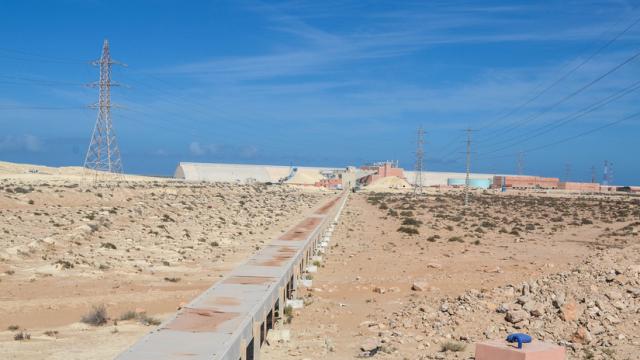There isn’t much in the Western Sahara, but there is this giant conveyor belt running over 100km from a Moroccan phosphate mine to the edge of the ocean. Look closely — this could be the future of our global food supply.
If you haven’t heard of Western Sahara, it’s because the “non-self-governing territory,” to use UN parlance, has been occupied by Morocco for several decades. There’s a reason that Morocco doesn’t want to let go. It currently controls 85 per cent of the world’s reserves of phosphate rock, much of which actually lies in Western Sahara.
And phosphate happens to be a key element in every living thing on earth. Fertiliser made from phosphate rich rocks are necessary to grow nearly every crop; it underlies the bread we eat, the corn ethanol we use to fuel our cars. It is likely that there are phosphorus atoms in your DNA that came from food which, in turn, came from fertiliser that originated as phosphate rock along this conveyor belt.

As infrastructure, conveyor belts are a handy means of transporting continuous streams of ore through roadless terrain. When operating, this conveyor belt can shuttle 2000 tonnes of rock per hour from the mines of Bou Craa to the port city of El-Aaiun, where cargo ships full of phosphate rock depart for ports around the world. Wind has strewn phosphate dust all around the belt, resulting in a curious white streak on satellite images.
Bou Craa is a large Moroccan-controlled mine in Western Sahara, but much of the region’s phosphate reserves actually remain untapped. As other big producers such as the US and China actually ramp down production due to dwindling reserves, this oft-forgotten piece of land will become increasingly valuable to the world. Political instability in this occupied territory could easily ripple into price increases for the global food supply. A 2011 protest inside Morocco, for example, blocked a railway linking phosphate mines and fertiliser plants.
From photos and satellite images, this conveyor belt in Morocco looks distant and isolated. But in reality, it is the first stretch in a long phosphate chain that eventually makes it way to us. Break it and we, sitting thousands of miles away, will likely feel the consequences. [Amusing Planet, The Sieve]
Pictures: jbdodane/Flickr, Conveyer Belt Guide
